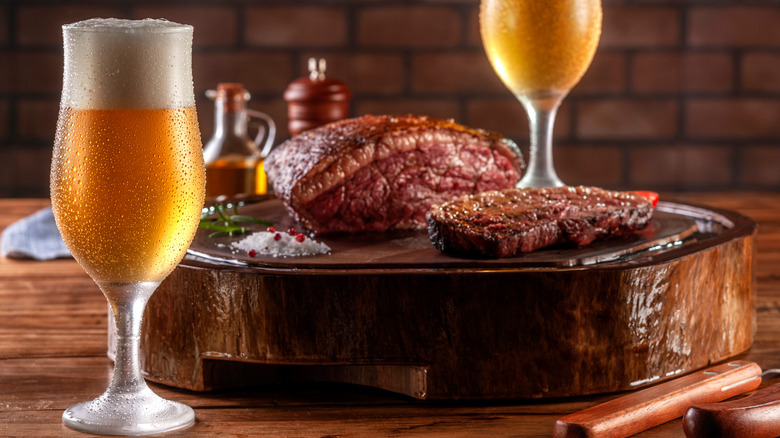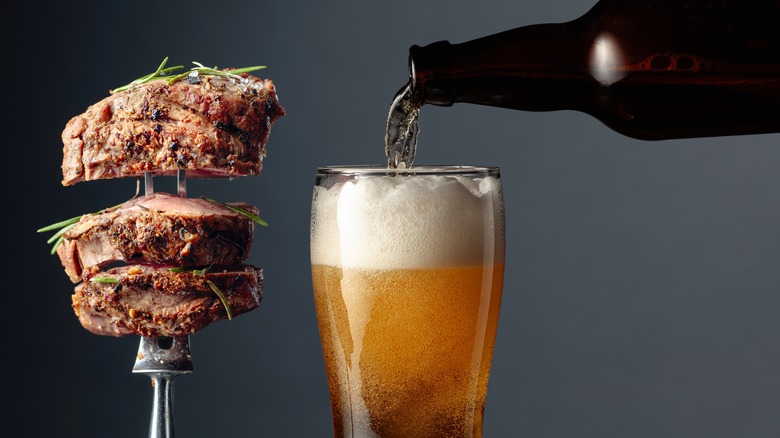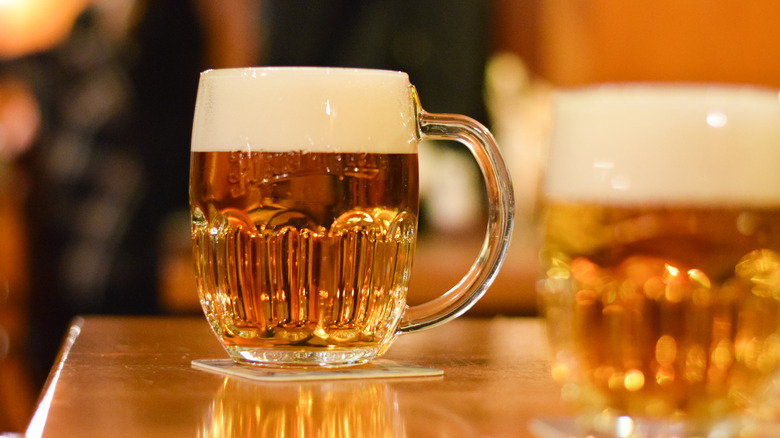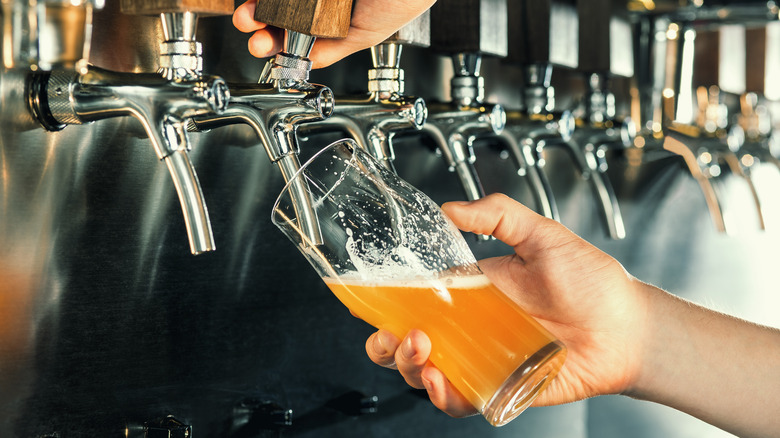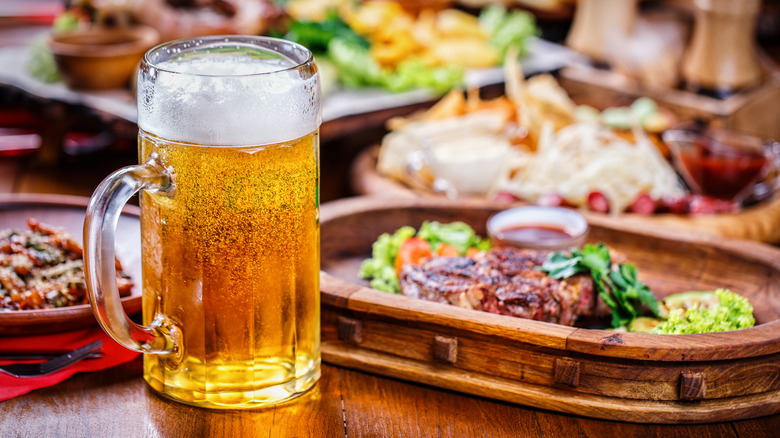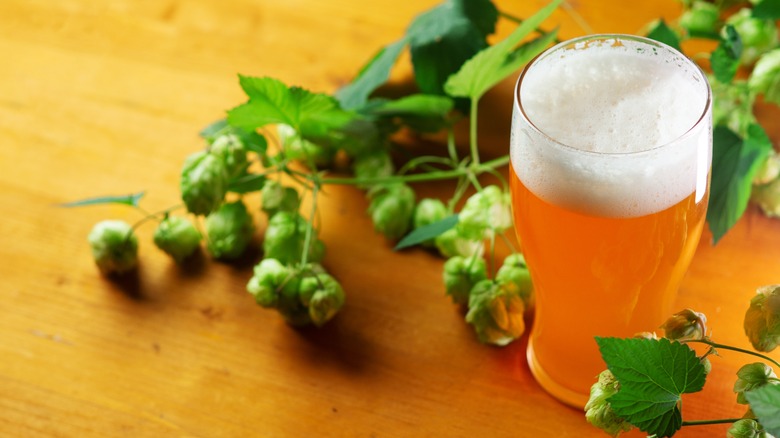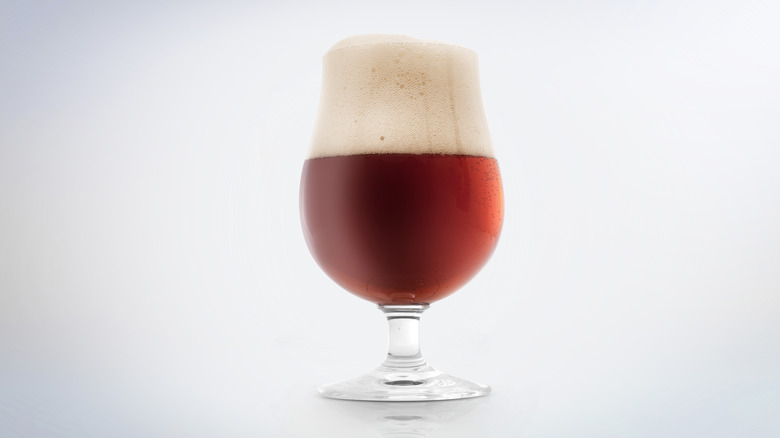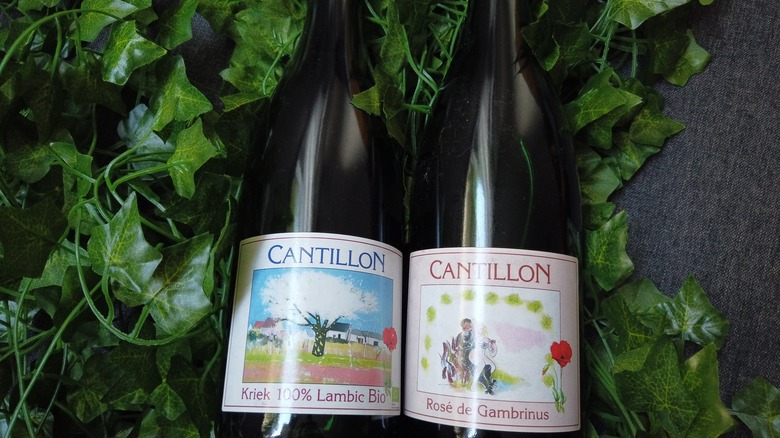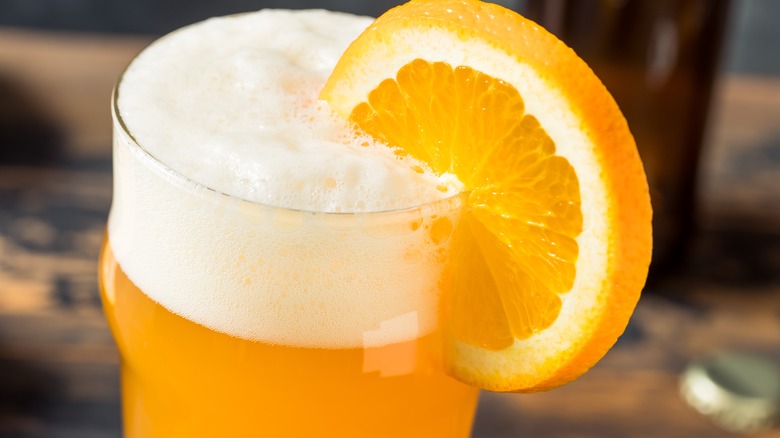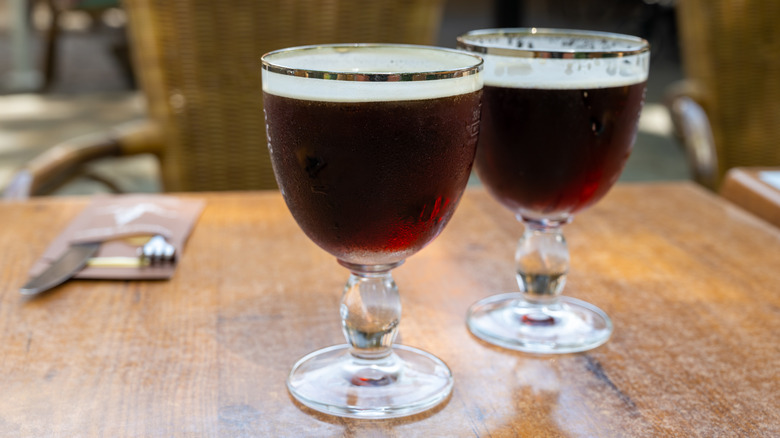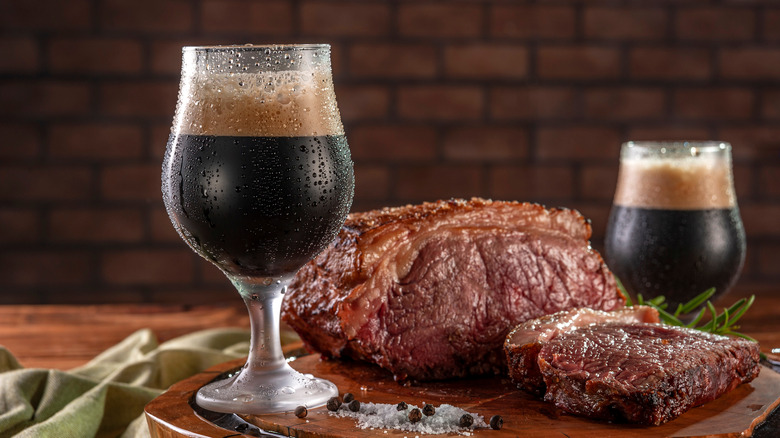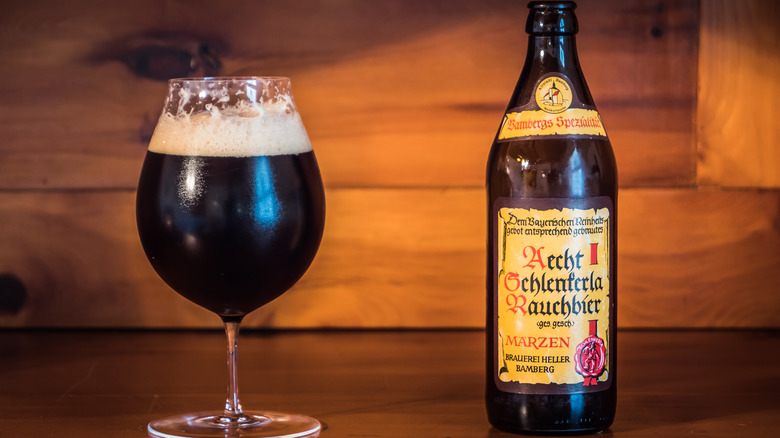The Absolute Best Beers To Pair With Steak
Even for the most highfalutin diners, those accustomed to avant-garde tasting menus and somm-paired wine flights, there's a deeply ingrained appeal to tucking into a simple steak dinner. Maybe it's evolutionary, some vestigial synapse in our primitive brains that lights up at the whiff of meat meeting fire.
Even the fanciest cuts off the most pampered Wagyu cattle benefit from an uncomplicated touch. Most great steaks don't need much more than some salt and pepper, the smoky kiss of a hot flame, and (maybe) a good slather in some rich melted butter.
While the obvious choice might be to pour a heady glass of Bordeaux or a buxom Napa cab to go with our succulent steak, we feel that the wide world of beer offers so much more to the pairing game than many realize. With such great complexity and variety available among seemingly endless beer styles (and even more infinite iterations on those styles), pairing beer with steak opens up realms of flavor and experience that the two humble ingredients on their own can't hope to achieve.
And why wouldn't they pair beautifully together? If our primal selves identify steak as among the great luxuries of human survival, it only follows that beer, a beverage with a tradition dating into prehistory, should evoke similar limbic responses. Read on for our best guidance on how to get the most out of pairing the world's great beer styles with your favorite cuts and preparations of steak.
Tips for pairing beer and steak
Between all the cuts of beef and seemingly infinite styles of beer, the number of pairing combinations might feel overwhelming. The first question to ask yourself when finding a great pairing is, "Do I like this?" If putting a robust, malty stout with a classic filet au poivre tastes good to you, then you've made a successful pairing. There are, however, some general guidelines to help you find the pairings you'll like best.
"For me, I think about flavor contrasting or balancing," says certified cicerone Jake Maddux, former owner of Austin's The Brewer's Table, a high-end brewery and fine dining restaurant. As is true with wine pairings, find a beer that matches the intensity of your steak. A fattier cut, for instance, could benefit from a stronger beer with a tart or bitter profile, whereas a leaner, more delicate steak might gain from a lighter-bodied beer.
"Beer is very palate cleansing," says John Legnard, brewmaster at Blue Moon Brewing Company. "The effervescence pulls all the food particles off your tongue and gives you a fresh taste." It isn't just beer's carbonation that helps wipe the palate clean. Beers that are bitter or sour cut through the richness of your steak. Likewise, an ice-cold beer offers both flavor and refreshment. "I never tell anybody what they should do," says John. "I tell people, don't be afraid to experiment. Try something new."
Pilsner
Pilsner may be the most widely enjoyed beer worldwide. With its light color, brisk bitterness, and sparkling carbonation, this Czech-style light lager is an approachable favorite for nearly all beer drinkers. These qualities also make pilsner a great starting place for pairing with steaks of all kinds. Pilsner's tartness and carbonation provide a great contrast to an unctuous, smoky, grilled piece of beef, but it's also proof that the art of pairing goes beyond matching flavors. A good pairing creates an atmosphere around your meal.
"Most steaks I do are outside over open fire, so, for me, it's all about light and cold," says Jake Maddux, who appreciates pilsner for its relatively low alcohol content. He can crack one open while he builds his fire and still have his wits about him by the time dinner is served.
Marco Rodriguez, brewmaster and co-founder of Zilker Brewing Co. in Austin, agrees. "I would usually start by drinking a pilsner just 'cause I'm grilling out. It kinda sets the mood. It's hot by the fire! If I'm drinking a light lager, it's going to carry over to the meal."
"When I pair beers," says Jake, who is now the GM of Smōk Barbecue in Fort Collins, Colorado, "if they're getting brisket with the classic Texas-style salt and pepper rub — you have rich, you have fatty, you have all things that need a counterbalance to it — so what I look toward is a pilsner, something light and crisp."
Helles
When pilsner debuted in its namesake Bohemian city of Plzeň in the mid-1800s, it took the world by storm. Soon, brewers all across Europe were trying to emulate the new style. Everywhere, that is, except Bavaria. The German region known for its traditional darker beers held out for decades before market demand and an innovative spirit led the brewers at Spaten, one of the largest breweries in Munich, to develop a new golden lager (via Kegerator.com).
While pilsner is known for its bitter bite because of its mellow malts and hop-forward profile, helles — which translates as "light" or "pale" — distinguishes itself with a rounder mouthfeel thanks to a stronger malt character. But the differences between the two are relatively nuanced. Both pilsner and helles are light and low in alcohol, making them both incredibly versatile choices for pairing with steak.
"A traditional German-style lager just cuts through all the smoke, cuts through all the fat, and it's super refreshing," says John Legnard at Blue Moon.
If we were to try and distinguish the two styles for pairing purposes, we might suggest putting a helles with a leaner cut like skirt steak, flank steak, or tenderloin, and letting pilsner, with its tart effervescence, play with the fattier cuts like ribeye. Helles has a slightly heavier body than pilsner, a bit lower carbonation, and it reads a little sweeter on the palate, all things that will play nicely with a cut that isn't oozing with umami-rich fat.
Saison
Saison, also known as farmhouse ale, is the Franco-Belgian answer to the pilsner craze that swept Europe in the late 19th and early 20th centuries. Saisons were an agricultural product, brewed by farmers across the French-speaking Belgian countryside. Ranging from hazy to clear, with alcohol content from 3.5% ABV up to around 7%, saisons are known to reflect their terroir more than some other more homogenized styles.
According to Brent Dawson at Best Beer Near Me, saisons have their pastoral qualities in common. Like pilsners, they tend to be high in carbonation with enough zing to scour your palate clean. Aromatically, however, they've got a lot more attitude, often showing citrusy, spicy, or herbal characteristics. Tasting a saison may have you recalling the barnyard, with notes of fresh hay and maybe some funkier aspects reminiscent of the stables.
Saisons are perfect pairs for any steak grilled on an open flame. Their strong character will hold up to the most flavorful steak, but their nuanced, sophisticated palate would also pair nicely with fine-dining preparations.
"If I were having a cast iron skillet filet mignon in a béarnaise sauce in a classic French preparation like that," says cicerone Jake Maddux, "I would go to something like a light farmhouse ale — something with some acidity and crispness to it, and maybe a little bit of sourness."
Pale ale
Pale ales were first brewed in England in the 18th century and are responsible for introducing the craft beer movement to the United States. While a British pale ale tends toward a maltier profile balanced with fragrant hops, American pale ale is brighter, cleaner, and more hop-forward (via Beer Advocate). Often relying on the Cascades varietal of hops for its trademark pine and citrus aromatics, APA, with its bolder flavors and mouth-watering bitterness, is a perfect beer to pair with steak.
John Legnard recommends a pale ale with sirloin or NY strip cuts, "Something that's meatier but not as rich."
Staying true to his Texas roots, Marco Rodriguez suggests pairing pale ale with barbecue brisket. "It has more flavor than a light lager, more body, and aroma, but not quite a traditional IPA which can have a big bite to it."
American pale ales trace their origins to California in the 80s with the now-ubiquitous Sierra Nevada Pale Ale. APAs therefore naturally gravitate toward the zesty lime and bright cilantro you see in Mexican dishes. They're a perfect companion to a steak taco or sizzling steak fajita. Kate Baker, co-founder of Craft Beer Cellar in Belmont, Massachusetts, and co-owner and executive chef at the neighboring beer hall, Trinktisch, loves pairing pale ale with spicy foods like salsa or a chile-forward steak rub. "A pale ale, especially one with a citrusy component, can soothe the palate between each bite, working to cool down the spice notes or tanginess."
IPA
According to apocryphal history, India pale ale came about during the height of Britain's colonial occupation of India during the 18th and 19th centuries. Legend has it that brewers were advised to add extra hops as a preservative to the stocks of pale ale they exported to the far-flung colony. In their attempt to keep the beer fresh on its long journey, they inadvertently invented a new style, notes Beer Connoisseur.
Today, IPA is among the most popular craft beer styles in the U.S. Thanks to the second round of hops in the brewing process, IPA tends to be more aggressively bitter than a pale ale, with more pronounced floral and grapefruit notes, and higher alcohol content. While some feel that assertive IPA is difficult to pair with food, salty, smoky, grilled steak works beautifully with IPA's piney, resinous qualities, especially when it's served very cold (via CraftBeer.com).
"Something with a richer, more fatty element to it, like a ribeye steak or a T-bone, will do really well with a beer that has a hefty amount of bitterness, like a West Coast-style IPA," says Kate Baker. "The now ubiquitous New England-style IPA works wonders with a blackened steak — the soft, juicy mouthfeel of these beers, often with a tropical note, helps to tone down the spicy notes of the rub."
Amber ale
Amber ale is another American derivative of a traditional British pale ale. Characterized by its deep copper hues attained from the use of caramel and crystal malts in the brewing process, amber ale boasts toasted toffee notes and a strong malt presence. The ensuing sweetness is then balanced by citrusy American hops making amber ale a fantastic beer to pair with steak (via CraftBeer.com).
Whereas many of the beers on this list are chosen to contrast steak's rich umami characteristics, amber ale's toasty caramel qualities along with its earthy bitterness make it a well-balanced pairing for any cut of grilled steak. It's also a great lesson that pairings go in both directions: Beer is often thought of as an element used to enhance the flavor of the steak. In this case, the reverse can be true, with the charred crust on the steak acting to magnify the rich, malty qualities in the beer. Despite its heavier body and sweeter profile, amber ale is an ideal beer for a backyard cookout, especially as autumn approaches.
Sour beer
Sour beers have gained recent explosive popularity in the U.S., but their pedigree predates human understanding of the fermentation process. The styles we call "sour beers" — lambic, gueuze, and Flanders red ale among them — originated from spontaneously fermented brews in medieval Belgian monasteries (via Craft Beer & Brewing).
"Sours have some similar attributes to wine," says Marco Rodriguez. "A blackberry kettle sour could be a cool substitute for red wine if you're typically a wine drinker with your steak. It's going to give you those dark berry notes you get out of a red wine."
In the same way fruity sour beer like a lambic would go well with a charcuterie board featuring country pâte and ripe cheeses, it would also compliment the nutty, blue cheese qualities of dry-aged ribeye while also acting as a palate cleanser between bites. "With a sour beer and a dry-aged steak, you've got a lot of those same characteristics," says John Legnard. "You've got oxidation, some kind of a funk – they're very complimentary."
"If I were to get a dry-aged tomahawk ribeye," says Jake Maddux, "I would do a Rodenbach, which is like a classic Flanders red ale — a little bit of tart, a little bit of acid."
The possibilities are vast no matter what style of sour you choose. The inherent complexity of sour beers — expressions of their hyper-local terroir — along with the vast variety and diversity available offers enthusiasts endless opportunities for new pairings.
Wheat beer
Wheat beers are known by a few names with their own distinguishing characteristics, but one thing is true of them all: They are great beers to pair with all kinds of food.
"When you're looking at something lean, a filet mignon which is very non-fatty, I look to something sweet," says Jake Maddux.
German-style hefeweizen, with its characteristic notes of banana and clove, is a flavorful beer that will stand up to more heavily spiced, leaner cuts like a skirt steak found in Mexican dishes, or smokier preparations like Texas barbecue (via Fiona Beckett at Matching Food & Wine).
Belgian witbier — literally translated as "white beer" — sports a lighter profile, and is often brewed with additives like citrus peel and coriander, according to Allagash Brewing Co. This style is often compared to dry white wines like Alsatian riesling for its versatility in pairing. John Legnard, brewmaster of America's most popular wheat beer, celebrates this style as a perfect food beer. "With a filet mignon or a lighter steak, a lighter beer like a Blue Moon Belgian White where it's crisp and refreshing so that you're cleansing your palette every time and you can taste the next bite of steak is pretty important."
Belgian Dubbel
Originating in the mid-19th century from the Westmalle Abbey in Belgium, Dubbel is a relatively strong brown ale with a heavy malt backbone and a striking level of carbonation. This commercial beer the monks sold was twice as strong as the beer they drank at the Abbey, hence the name "Dubbel," Dutch for "double" (via VinePair).
Unlike other darker beers on this list, Dubbel's deep color doesn't come from toasted malts, but rather from caramelized candi sugar, a common ingredient derived from sugar beets found in several Belgian beer styles. According to CraftBeer.com, candi sugar accounts for Dubbel's chocolate, raisin, and burnt caramel qualities.
When pairing a Dubbel with a steak, it's helpful to think of it like you would a wine. Its higher alcohol content — between 7.5% to 10% — makes it nice to sip with your meal, while its characteristics of dark fruit and cocoa go beautifully with steak. Its Belgian origins make it a perfect companion for a steak served with Trappist-style blue cheese like roquefort or stilton.
"A rich, buttery, melt-in-your-mouth filet mignon, sans sauce, lightly seasoned with freshly cracked black pepper, is amazing with a Belgian Dubbel," says Kate Baker. "The bursting effervescence of this beer style has the perfect palate scrubbing ability to tame the buttery nature of the filet, and to tame the black pepper notes."
Porter and stout
Porters and stouts are English ales born from a common lineage dating back to the early 18th century, and the line between the two styles remains a bit blurry even today. Porters came first, so named because of their popularity among street and river porters along the London piers, notes Zythophile.
As beer became more popular, brewers began producing porters in varying styles and strengths. The stronger porters became known as "stout porters." Demand for the higher alcohol beer led to double, triple, and imperial stout porters, which over time became known simply as "stout" (via Truly).
Both porters and stouts get their dark, nearly black color from the flame-roasted malts that impart their trademark chocolate, caramel, and toffee flavors. Modern stout beer is less defined by its alcohol content (Guinness, the world's most famous stout, is only 4% ABV), and more by flavor characteristics. Very generally, porters have a hoppier profile, while stouts are maltier with deep coffee notes.
"If you're looking at a rich prime rib where it's fatty and has this oozey deliciousness," says John Legnard, "you probably need a stronger flavored beer. A darker or richer beer might go well with a prime rib."
"If someone is a medium-well to well-done steak eater," says Kate Baker, "a beer to match up to the additional char factor suggests a resonant pairing. The roast of beers like porters or stouts can also be a palate reset."
Rauchbier
Up until a few hundred years ago, all beers were "rauchbier" (literally meaning "smoke beer") because flame-dried malts would carry a smoky flavor over to the beer it was used to make. When indirect methods of air-drying malts came into fashion, traditionalists in Bamburg, Germany refined the style we now know as the smoky, malty lager called rauchbier (via American Craft Beer).
"Smoked beers are one of my favorite things on the planet," says John Legnard. "When you get a good rauchbier, and you've got the right balance between the malty sweetness, a little bit of hops, the smoked malts, and then the sweetness of the finished beer, it's like one of the most refreshing things on the planet because it's tricking you to think it's going to be dark and bitter, but it's really sweet and smooth with a smoky hint."
Contemporary rauchbier is made by smoking the malts over beechwood, giving it a hickory-like flavor reminiscent of bacon (via German Food Guide). American craft brewers, never to be hemmed in by tradition, have taken that cue and applied it to all kinds of different styles, especially porters. To pair steak with a rauchbier, it's helpful to think in terms of complimentary flavors, in this case putting smoke with smoke. Smoked beers can go well with barbecue brisket or a smoked prime rib roast, especially if they have an acidic component like a vinegar-based barbecue sauce or a dollop of horseradish sauce to offset the fat.
